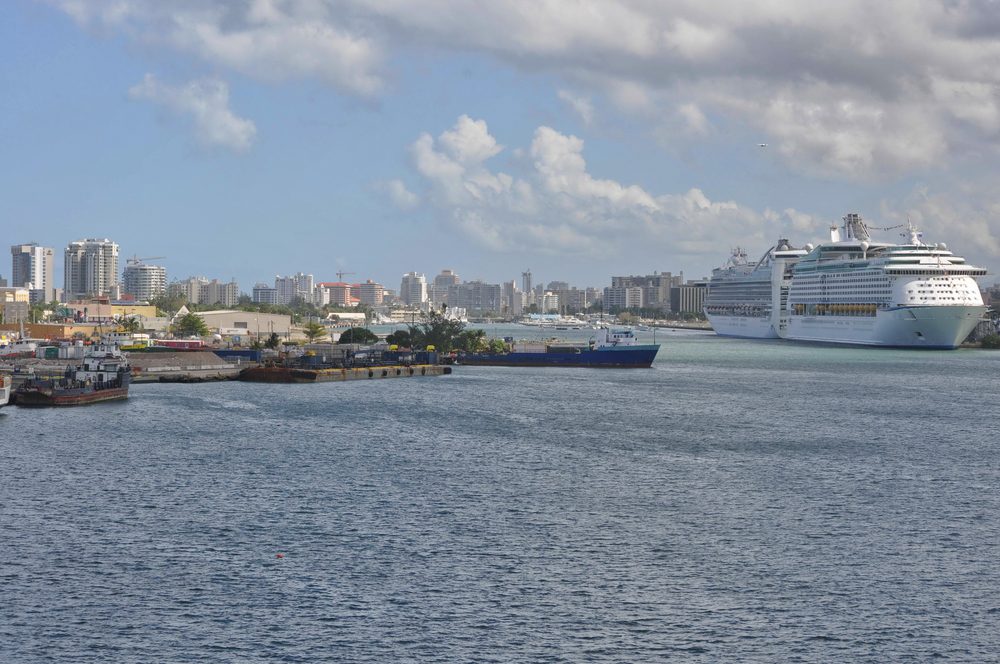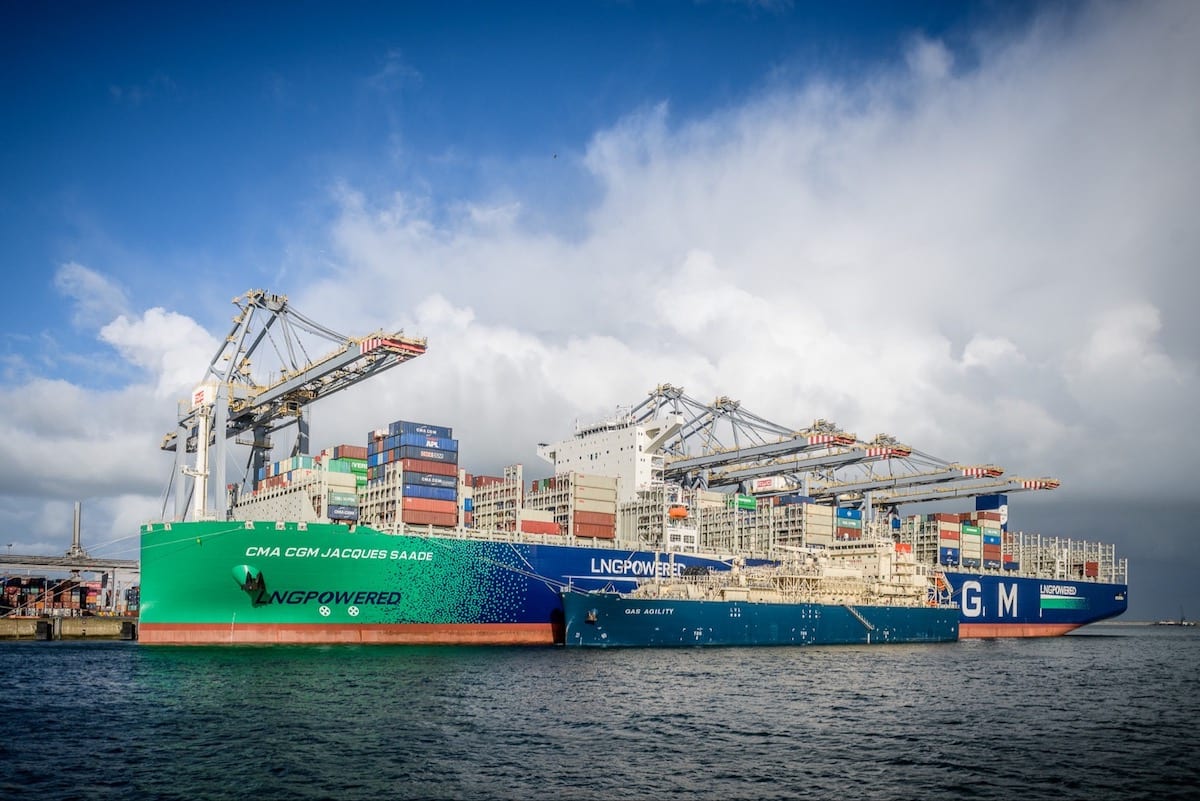File Photo: Cruise ships in San Juan Harbor, Puerto Rico. Photo: By Nenad Basic / Shutterstock
By Nikki Ekstein (Bloomberg) — Almost three months after Hurricane Maria battered Puerto Rico as a nearly Category 5 storm, a third of the island is still without power. Roughly two-thirds of its 45,000 small businesses suffered closures, with as many as 10,000 planning never to reopen their doors. Just 129 miles away, the British Virgin Islands has begun to shift from crisis mode to recovery following earlier devastation by Hurricane Irma, with cleanups still under way on land and along coastlines.
But in recent weeks, a beacon of hope has arrived on each destination’s harbor: cruise ships. With no real need for on-land infrastructure, the first three vessels to pull into Tortola and Virgin Gorda since Irma—the 62-passenger Crystal Esprit, the 112-passenger SeaDream, and the 2,076-passenger Marella Discovery—dropped anchor in the first two weeks of December. The BVI’s most prominent yacht companies, Sunsail Ltd. and the Moorings, also restored their charter services on Dec. 9.
Meanwhile, in Old San Juan, a welcoming celebration was held on Nov. 30 as a reminder—to locals and the first 7,000-odd, post-storm cruisers—that Puerto Ricans are proficient in both willpower and complex rhythms. Following that day’s twin arrivals of Royal Caribbean Cruises Ltd.’s Freedom of the Seas and Carnival Corp.’s Conquest, the port has resumed its full cruise operations, with regular calls from more than 10 companies, from Norwegian to Viking to Celebrity Cruises.
For San Juan residents, this is a milestone worth celebrating. “If there is something that distinguishes Puerto Ricans, it’s our spirit of hospitality,” said Carla Campos, chief marketing officer of Puerto Rico Tourism Co. And celebrate they will: From now until the end of January, locals will continue to party for every cruise that arrives in San Juan. “Everyone that’s arriving via these cruise calls will see music and traditional performances on the streets,” Campos said. “All the shops are open. Businesspeople are putting together specials and decorating.”
Campos expects cruises to have a total economic impact of about $25 million in November and December. That figure represents 58 cruise arrivals and 110,000-plus visitors—numbers that don’t deviate significantly from Puerto Rico’s norm, she said. That the industry has sprung back so quickly, and with such full force, is no accident.
“We’ve personally hosted top-level executives from each cruise line to allow them to see firsthand the resiliency of our services and infrastructure, and that has allowed us to resume our calendar of operations intact,” explained Campos.
In financially downtrodden Puerto Rico—which was on the brink of bankruptcy before the storms—tourism has always been an economic silver lining, accounting for as much as 15 percent of gross domestic product. In the British Virgin Islands that figure shoots to as high as 30 percent. But there, a different story is unfolding.
“The cruise pier is operational and able to receive ships,” said Sharon Flax-Brutus, the BVI’s director of tourism, “but we’re not accepting larger ships to our destination—ones that are 4,000-plus passengers—until we can rebuild more of our infrastructure.”
Flax-Brutus’s office estimates that cruise passengers spend an average of $89 onshore—a number that, while not extravagant, added up to $45 million in 2015. That can go a long way for communities in Tortola and Virgin Gorda that have lost everything from their homes to their full-time employment. But there’s a catch: “We’ve built a brand equity and brand loyalty for the BVI as a luxury destination,” Flax-Brutus said, “and we want visitors to return when we are proud of what we have to offer.”
She’s not the only one worried that short-term gains might imperil a full, long-term tourism recovery. “We have a standard that we have to uphold in this territory of the Virgin Islands,” government representative Melvin Turnbull told BVI News last week, “and it must not be dumbed down that we have to say that we are opened for business and we are ready to receive people when in fact that we are not.”
If reputation is at risk, so is morale—and a local workforce that could decamp to greener pastures if they can’t find employment again soon. That’s why David Johnson, whose Victor International Corp. developed Oil Nut Bay on Virgin Gorda, is racing to reopen the resort on Dec. 16. “People need to come back,” he said. “The locals want them to come back, they need them to come back … that’s their lifeline.”
“When we reopen, we’ll have 65 staff permanently employed and 200 contractors,” he added. That’s an encouraging first step for a country where 34.5 percent of the workforce is directly employed by tourism. As for the impact of each new cruise, each hotel reopening, each restaurant flipping over its “closed” sign? “Every one of these milestones is absolutely critical,” he said.
The Experience for Visitors
Cruise ships won’t call on destinations that aren’t well-equipped to receive their passengers safely, which is why, until now, travelers have seen alternative ports on their itineraries. For many travelers, cancellations aren’t the answer: Most companies charge penalties or fees to reschedule sailings or offer only partial refunds.
“Having just been in San Juan in late spring, I wasn’t sure what I would see when I arrived there earlier this month,” said Steve Simao, Windstar Cruises’ director of sales, who visited aboard the Star Pride. “Did I see a city and an island in recovery? Yes. I didn’t see devastation. Mostly what I saw was life.”
Meaning street life—in San Juan, stores and restaurants are open. Signs of lingering damage include nonoperational traffic lights, electricians working on poles and wires along the streets, and buzzing generators.
This month, three of Windstar’s small-ship cruises will leave from the Puerto Rican port, taking with them a total of 608 passengers.
Although few cruise companies are proactively offering excursions that allow travelers to contribute to the recovery, Puerto Rico Tourism is making it easy for those who want to help. “We rolled out a meaningful travel program that takes travelers to attractions that still need a little more cleanup—some great beaches, the Camuy cave system, that sort of thing,” said the tourism company’s Campos. This way, she explained, travelers can see the island’s most beautiful corners while rehabbing them for future generations.
In the BVI, recovery is taking longer, and efforts aren’t as centralized. The new BVI Art Reef is open for divers and snorkelers; restaurants on Tortola, Virgin Gorda, and Jost Van Dyke are steadily reopening; the iconic, boulder-lined trails at the Baths National Park have been reengineered and made safe for visitors; and several beaches are back to their sandy status quo. That offers plenty of activities for day-trippers coming off cruise ships. It also puts excursion managers and tour operators back in business.
A grass-roots energy is also helping. Notably, locals are setting up “pop-ups” in tents on the beach to bring a beach party vibe to once-popular areas such as Cane Garden Bay, where brick-and-mortar establishments have yet to reopen.
“We’re adding music, too,” said Flax-Brutus, the tourism director. “We’re working with local vendors in the neighborhoods—we’re trying to do the best thing for everybody.”
Rebuilding
In both Puerto Rico and the British Virgin Islands, there’s plenty of uphill climbing left to do. Roads need to be rebuilt. Trees need to be cleared. Crucially, more hospitals and schools need to reopen.
Oil Nut Bay’s Johnson says it will likely be a full year before his fellow luxury hoteliers can start taking reservations again; in Puerto Rico, the lush islands of Vieques and Culebra are waiting to celebrate their own comebacks in the coming weeks and months.
“Mother Nature needs time to heal,” explained Campos. “Hopefully towards the end of 2018 we can see the El Yunque rainforest open again for visitors,” she added. Top-tier resorts like Dorado Beach, a Ritz-Carlton Reserve, will also remain closed for renovations until next fall.
But optimism is in the air. Said prominent Puerto Rican chef José Enrique: “People are going out and having fun—struggle shakes things up, I believe. You can see nightlife coming back, everybody that comes in the restaurant is extremely happy that we are open, and this ends up creating such a feel-good vibe.”
Campos sees an additional silver lining. “Now that we’ve been in the headlines for so long, travelers know more about us,” she said. “Maybe we weren’t on their radar before, and now we are.” Her Puerto Rican pride was palpable. “Yeah, we got hard hit, but now we’re back up and running. And since you’ve been watching, the best way to help is to come and see us for yourself.”
© 2017 Bloomberg L.P
Unlock Exclusive Insights Today!
Join the gCaptain Club for curated content, insider opinions, and vibrant community discussions.

 Join The Club
Join The Club













